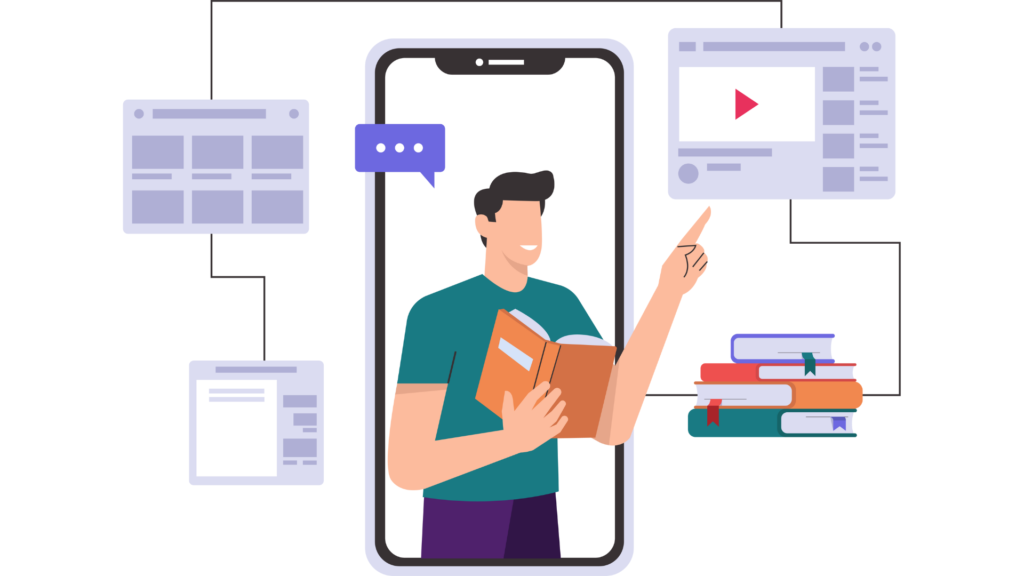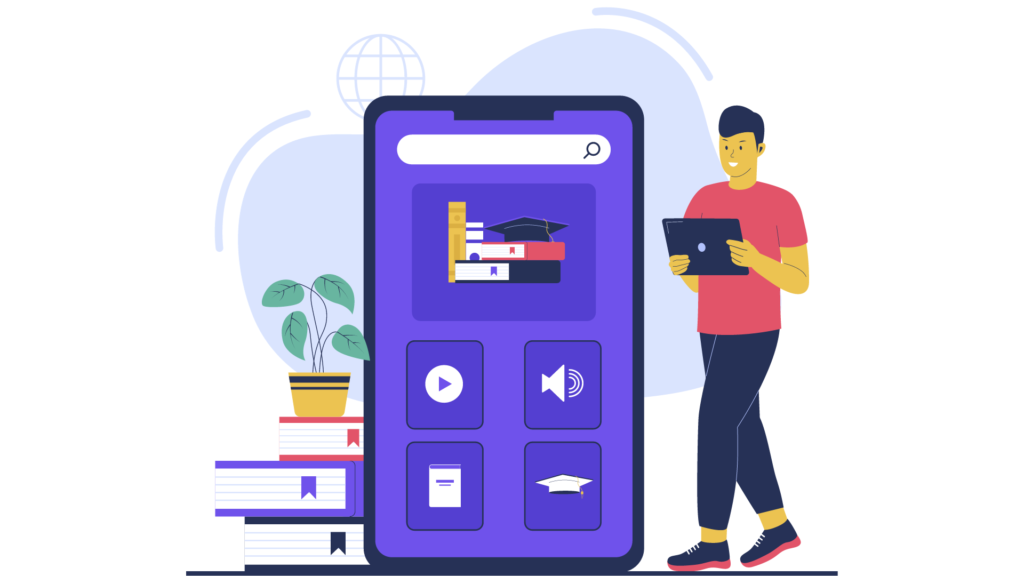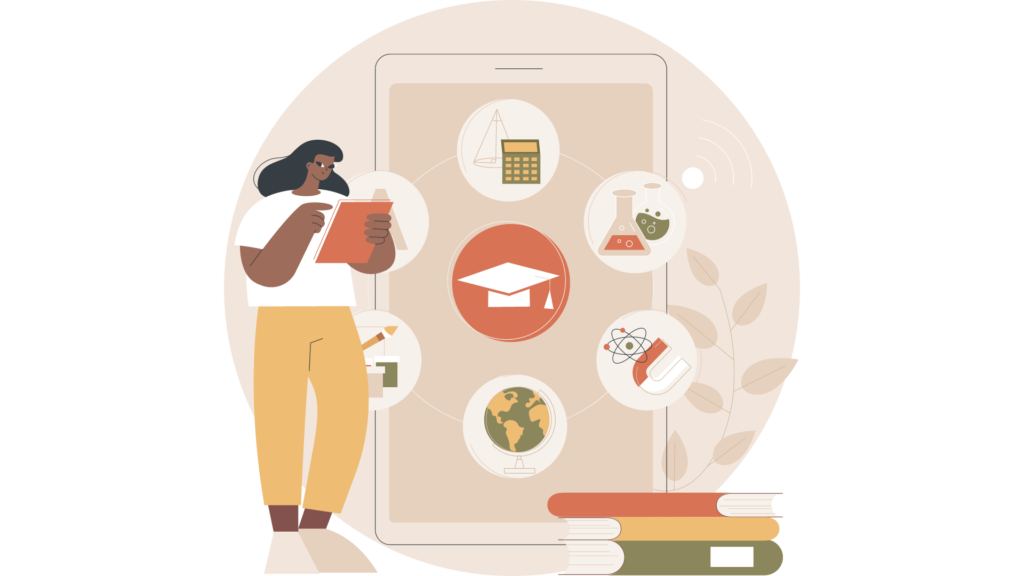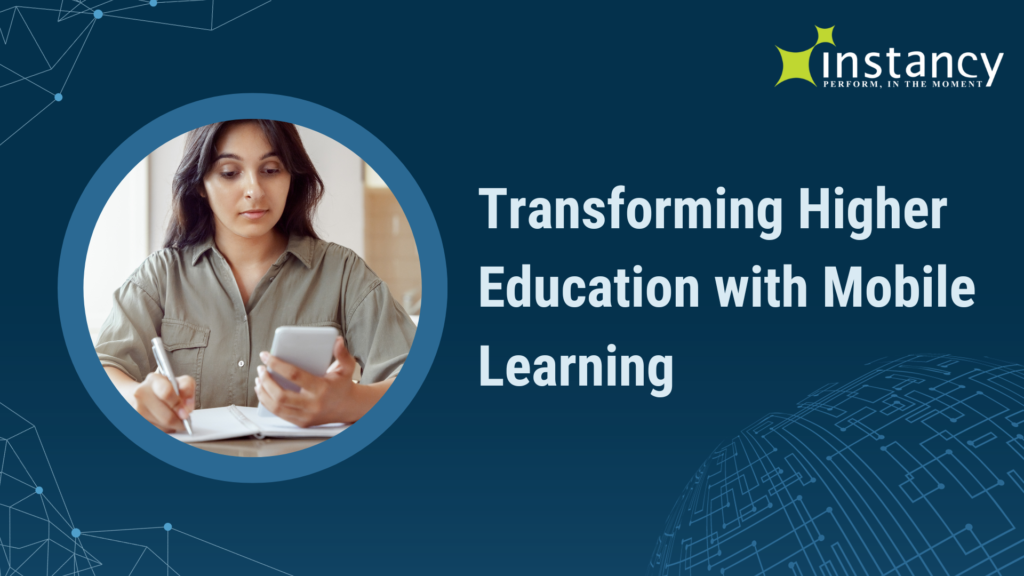Brief Introduction
We can’t imagine life without smartphones in today’s fast-paced digital environment. They have completely altered our methods of contact with one another and the world. It’s no wonder that mobile devices are changing many facets of our lives, including schooling, given their rising prevalence and appeal.
M-learning, or mobile learning, refers to utilizing portable electronic devices—specifically smartphones and tablets—to advance educational goals. It allows mobile access to educational materials, peer-to-peer collaboration, and interactive learning opportunities for students and faculty.
There are many reasons why mobile learning has become increasingly popular in higher education. Students can learn whenever and wherever it is most convenient for them, thanks to the availability of information online. With the advent of mobile learning, students now have access to a wealth of instructional materials regardless of where they are: on the bus, in the lobby, or at home.
Additionally, mobile learning offers a dynamic and interactive education. Students can participate actively in their education with multimedia features, including films, animations, and quizzes. They will learn more and retain it longer with this engaging and dynamic method.
Mobile learning also has the added benefit of allowing for individualized instruction. Students now have greater control over their educational experience by using mobile apps and platforms to obtain individualized curricula. This individualized strategy increases students’ enthusiasm and engagement and directs their efforts toward improving their weakest areas.
Mobile learning makes it easier for students and faculty to collaborate on projects and share resources, which are crucial to the educational process. Learners can build relationships with one another and their faculty using virtual classrooms, message boards, and other real-time communication tools.
The efficiency and effectiveness of mobile learning is also improved. Students can save time and improve their time management skills by using mobile devices to take notes, access course materials, and turn in assignments. This efficiency helps students save time and frees them up to focus on mastering the material to a deeper level.
Despite its many advantages, mobile learning is not without its difficulties. Institutions face challenges when implementing mobile learning initiatives, including device and network restrictions, security and privacy concerns, training and support for educators, and content adaption and design.
Following this brief introduction, this essay will go more into the advantages of mobile learning in higher education, talk about the difficulties encountered by institutions, examine some examples of successful mobile learning projects, and conclude with some suggestions for how to go about implementing mobile learning. The future of mobile learning in higher education will also be discussed, including new technologies, trends, and potential effects on instruction.
Get your mobile device ready and come along as we investigate the revolutionary potential of mobile learning in higher education. In the following part, we’ll talk about how mobile learning may improve higher education.
Benefits of Mobile Learning

The widespread use of mobile learning has had far-reaching effects on the higher education sector. Students now have access to many materials 24/7 thanks to the widespread availability of mobile devices like smartphones and tablets. This ease of access has revolutionized the educational process by making it more interesting, dynamic, and individual.
Information Easily Available Anytime, Anywhere
The flexibility to study wherever and whenever suits you is a major benefit of mobile learning in higher education. Mobile technology has liberated pupils from relying primarily on books and classroom instruction. With just a few touches on their screens, they may gain access to an abundance of learning materials such as textbooks, articles, and online courses. Students can study on their own time and at their own pace, whether at home, in class, or elsewhere.
Exciting and Participatory Educational Environment
Compared to conventional approaches, mobile learning provides a more interesting and dynamic learning environment. Mobile learning apps and platforms allow instructors to combine media like movies, animations, and quizzes into classroom activities. Students’ attention is held, and their comprehension and retention of the subject are improved with multimedia. Mobile learning can increase student engagement and motivation with gamification components like badges and leaderboards.
Learning Experiences Tailored to Each Individual
Personalized learning experiences are another major advantage of mobile learning. Thanks to mobile devices, students now have the freedom to study anywhere and however they like. The mobile learning platform can adjust to the needs of each student and make suggestions based on their performance. By tailoring lessons to each student, we can guarantee they will be given the appropriate amount of challenge without being overwhelmed.
Interaction and Cooperation
Thanks to mobile learning, Students and faculty can work together and exchange ideas. Students can interact with one another and their faculty outside traditional lecture hours using tools like message boards, chat rooms, and video conferencing. Sharing information, analyzing problems analytically, and working together effectively are all fostered here. It encourages students to get invested in their education and to feel like they belong in the school community.
Increased Effectiveness and Productivity
Using mobile devices in the classroom increases efficiency and effectiveness for everyone involved. Students can make the most of their study time by using their mobile devices to access study resources during short breaks or on their commute. They can use mobile learning apps to keep on track, remind themselves to study, and keep tabs on their progress. Faculty can devote more time to instructional design and student support thanks to mobile learning platforms that automate administrative activities like grading and feedback.
As we have seen, many positive outcomes are associated with mobile learning in higher education. Mobile learning has revolutionized the classroom in several ways, including by making material accessible at any time and by making lessons more interesting and interactive. It facilitates individualized instruction, promotes open lines of communication and cooperation, and raises output and efficiency. With the advent of cutting-edge tools like artificial intelligence and augmented reality, the future of mobile learning in higher education is looking brighter than ever.
Problems and Ways to Fix Them

Constraints Imposed by Hardware and Networking
The device and connectivity restrictions issue is a significant barrier to the widespread adoption of mobile learning in higher education. Not everyone can access a stable internet connection even if a student has a smartphone or tablet. Their participation in mobile learning resources and activities may suffer as a result.
Institutions can find creative solutions to this problem by, for example, allowing students to borrow gadgets or creating mobile learning laboratories where students can access the appropriate technology. Faculty can also create mobile learning content accessible without an active internet connection so that students can download materials and work on assignments even when they aren’t in range of a wireless network. Institutions can guarantee that all students can access mobile learning opportunities if they adopt these strategies.
Privacy and Safety Issues
Security and privacy issues are another barrier to mobile learning’s widespread use in higher education. Using mobile devices and internet platforms raises the possibility of data breaches and illegal access to private information. This is of the utmost importance with regard to student files and data.
Institutions should make strong security measures one of their top priorities to allay these fears. Encrypted and authenticated mobile learning platforms and apps are integral to this strategy. Faculty should also emphasize the need to teach their pupils how to protect their personal information online by creating secure passwords and avoiding disclosing private information. Following these measures, schools may guarantee that their children and faculty are always protected in mobile classrooms.
Faculty Preparation and Assistance
To successfully implement mobile learning in higher education, instructors must be equipped with the expertise to use mobile devices in the classroom. However, faculty must be familiar with the most up-to-date mobile learning technologies and strategies to truly embrace this revolutionary method.
To overcome this obstacle, schools need to invest heavily in faculty’s professional development. Mobile learning pedagogies and efficient application of mobile learning technology can be the subject of various educational opportunities. Institutions may give faculty more agency in mobile education by providing the knowledge and tools they need to design dynamic, interactive lessons for their students.
Designing and Adapting Content
One of the difficulties of mobile learning is making content suitable for mobile devices. Because of reading limitations on mobile devices, students may struggle to engage with traditional course materials fully.
Faculty can overcome this obstacle by creating optimized content for mobile devices that can be easily viewed and navigated on smaller screens. Multimedia features like films, interactive quizzes, and responsive design strategies can be used to accomplish this goal. Educators may guarantee their students a smooth and interesting learning experience by customizing and creating content specifically for mobile devices.
While integrating mobile learning in higher education is not difficult, there are efficient approaches to overcoming them. Institutions can create a successful mobile learning environment that improves the teaching and learning experience for all parties involved by considering device and connectivity limitations, security and privacy concerns, providing training and support for educators, and adapting content for mobile devices.
Use Cases

The widespread adoption of mobile learning can potentially redefine the landscape of higher education. By harnessing the power of mobile technology, institutions can create innovative, flexible, and personalized learning environments. In this context, we’ll explore three hypothetical use cases to illustrate how mobile learning can enhance various aspects of the educational process.
Utilizing Mobile Learning to Transform Educational Interaction
The introduction of mobile learning in an academic environment could completely alter how classes are run and how students interact with both course materials and each other. By implementing mobile learning platforms and apps, it becomes possible to cater to the modern needs of students.
The adaptability offered by mobile learning is a significant advantage, allowing students to access course materials, lecture recordings, and supplemental materials online at their convenience. This increased flexibility could lead to greater investment and motivation in education.
Collaboration and community-building are also enhanced using mobile devices. Tools such as mobile-based discussion forums and real-time communication platforms could foster critical thinking, creativity, and a sense of community among students.
Creating Dynamic Learning Environments through Mobile Learning
Mobile learning could enable an institution to transform traditional lecture halls into dynamic and engaging learning spaces. By creating mobile-friendly content that includes multimedia tools such as videos, quizzes, and simulations, learners may find it easier to comprehend complex subjects.
The adoption of mobile learning might facilitate active learning practices, empowering students to actively contribute to class discussions and engage with their peers in real-time. This method of instruction could enhance student retention and foster analytical and problem-solving skills.
Enhancing Educational Opportunities through Mobile Learning
Mobile learning has the potential to expand educational opportunities in various institutions. Using mobile learning platforms and apps, barriers to education delivery may be overcome.
One notable aspect of mobile learning is its impact on evaluation and feedback. The ability for students to receive instantaneous feedback and tailor their learning paths through online quizzes, assessments, and assignments could simplify evaluation processes and give students more control over their education.
Furthermore, mobile learning could bridge the gap between theory and practice. Providing students with essential information, tools, and resources on their mobile devices during field trips and practical sessions makes it possible to foster innovation, problem-solving, and the practical application of academic concepts.
These use cases demonstrate the potential of mobile technology to revolutionize higher education. By focusing on areas such as accessibility, collaboration, personalization of learning, and assessment, mobile learning initiatives might significantly boost student achievement and engagement, paving the way for more innovation in education.
In the following part, we’ll look more closely at how to use mobile learning in higher education.
Guidelines for Colleges and Universities Using Mobile Learning
When it comes to mobile learning in higher education, institutions may use a few tried-and-true methods to guarantee a positive return on investment. Best practices for mobile learning include determining what resources are needed, building them out, creating optimized content for mobile devices, using active learning techniques, and testing, tweaking, and enhancing the approach over time.
Assessing Requirements
Institutions should do a thorough needs assessment before plunging into mobile learning projects. To do so, one must first determine the desired outcomes of mobile learning and gain insight into the individual requirements and preferences of both students and faculty. Institutions can gain useful insights that can guide the development and implementation of mobile learning programs through surveys, focus groups, and interviews. This analysis will be useful in ensuring that the mobile learning initiatives serve the demands of the learning community and contribute to the larger educational goals.
Providing Sufficient Resources and Infrastructure
Institutions must provide the required infrastructure and support for mobile learning to be effective. One aspect of this is making sure the infrastructure behind the internet is solid enough to support the anticipated growth in users. High-speed internet, Wi-Fi hotspots, and mobile data plans are crucial for students and faculty to access educational resources and participate in group projects. To further ensure the success of mobile learning, educational institutions should provide access to technological support services. Facilitating the shift to mobile learning provides faculty and students training and resources.
Creating Material Optimized for Mobile Devices
To improve the studying experience on mobile devices, producing content compatible with mobile devices is crucial. Educational institutions must ensure that their course materials and resources can be accessed from any mobile device and run on any operating system. As such, it is important to implement responsive design principles to make content responsive to various screen sizes and orientations. Videos, quizzes, and simulations are all examples of multimedia features that can be incorporated to increase engagement and involvement. In addition, schools should think about using mobile learning apps or mobile learning platforms that provide functions designed for mobile-based education.
Implementing Methods of "Active Learning"
The advent of mobile technology has opened the door for students to ditch passive learning in favor of more modern, engaging, active learning techniques. Faculty should be encouraged by their institutions to create projects that foster teamwork, analysis, and innovation. Group work, online chats, video games, and simulated environments are all examples. Institutions can improve student engagement and learning results by implementing active learning practices. The ability to provide immediate feedback and evaluation to students is another way mobile learning helps faculty better support their pupils.
Always Assessing, Always Improving
The process of implementing mobile learning should be evaluated and refined regularly. Institutions need to evaluate the results of their mobile learning efforts frequently. Methods such as surveys, tests, and qualitative comments from faculty and students might help. Insightful judgments and improved mobile learning programs can be made with the help of data analysis on student performance, engagement, and satisfaction. The benefits of mobile learning can be maximized by evaluating their performance regularly so that institutions can focus on areas where they can have the most impact.
Institutions can use mobile learning’s potential to transform higher education by adhering to these guidelines. If done correctly, mobile learning may expand students’ access to higher education, boost their capacity for teamwork and communication, provide them with more chances for self-directed study, and boost their efficiency and output. Institutions must keep up with the latest trends and innovations in mobile learning to ensure they are at the vanguard of educational innovation as technology advances.
The advantages of mobile learning in higher education are discussed in more detail here.
The Potential of Mobile Technology for Academic Instruction
The future of mobile learning in higher education is quite promising as technology continues to develop rapidly. Artificial intelligence plays a crucial role in altering educational practices due to the emergence of new technologies and trends. Exciting and promising is the potential impact of these innovations on the field of education.
New Developments in Technology and Industry
New technological developments and social shifts will continue to shape the course of mobile education. These immersive technologies, such as Virtual Reality (VR) and Augmented Reality (AR), can potentially revolutionize classroom instruction. Envision a world where students can go on virtual field tours to famous landmarks or explore intricate subjects in a three-dimensional setting. Learning could be made more interesting, interactive, and memorable with the help of these tools.
Using game mechanics in education is another developing trend in mobile learning. Educators may create a more engaging and inspiring learning experience by introducing gaming features like quizzes, challenges, and rewards into educational content. In addition to raising participation levels, gamification has been shown to increase healthy competition and boost students’ feelings of accomplishment.
What Part Does Artificial Intelligence Play?
The function of Artificial Intelligence (AI) in mobile learning is no exception to the generalization that AI is one of the most revolutionary technologies of our time. Chatbots and virtual assistants powered by AI might provide students with tailored advice and direction, addressing their specific needs as they arise and easing their way through course contents. These smart systems can modify their recommendations and resources based on a user’s specific learning profile and preferences.
In addition, AI systems can sift through mountains of data to spot trends and patterns in student performance, giving faculty a clearer picture of where pupils are succeeding and where they need more work. With collected data, educators can better provide individualized and specific assistance to each student.
Possible Effect on Classroom Instruction
he potential of mobile learning to revolutionize educational practices in the future is exciting. Educators can better meet their students’ varying needs and interests by using mobile learning devices in their lessons. Students can now learn whenever and wherever it is convenient for them, thanks to the convenience of mobile devices and the Internet.
Mobile learning also encourages students to collaborate on projects, share ideas, and provide and receive real-time feedback. Students benefit from this method in their ability to think critically and solve problems and work effectively as a team, which are highly valued in today’s competitive job market.
In conclusion, the potential for mobile learning to transform higher education is immense. The incorporation of artificial intelligence and the proliferation of new technology is radically altering how students and faculty interact with course materials. As these developments continue, they will significantly impact how we educate future generations, making for a more individualized, dynamic, and adaptable learning environment for all students.
Conclusion

Finally, mobile learning has the potential to transform higher education by giving students greater freedom, easier access, and more exciting educational opportunities. The flexibility of mobile learning and its potential for individualized instruction and group work is only one of its many advantages. There are approaches to the problems of device constraints, security worries, and the requirement to train faculty that can be overcome.
Institutions may maximize the benefits of mobile learning for their students by completing a requirements assessment, providing enough infrastructure and support, creating mobile-friendly content, and implementing active learning practices.
Future developments in artificial intelligence are likely to expand the usefulness of mobile learning in the classroom considerably. Changes in evaluation and feedback, as well as student motivation and engagement, could result from the expanding capabilities of mobile learning. In addition to addressing underserved groups and facilitating chances for professional development and corporate training, mobile learning can go well beyond the confines of conventional educational environments.
As a result of harnessing the potential of mobile devices and technology, mobile learning is a potent instrument that can revolutionize higher education. Institutions can better prepare students for success in the digital age by adopting mobile learning strategies. Educators and institutions must investigate mobile learning platforms and maintain connections with the mobile education community to keep up with the newest trends and breakthroughs in mobile learning.
Feel free to peruse the Instancy blog for more information on m-learning, mobile learning technology, and other related topics. Embrace the promise of mobile learning to discover fresh possibilities for academic success.
The higher education landscape is rapidly evolving, driven by technological advancements and changing student expectations. Mobile learning, powered by Instancy’s cutting-edge technology, is at the forefront of this transformation, revolutionizing the way students access and engage with educational content. Mobile learning is reshaping higher education and empowering students and educators by offering a flexible, interactive, and personalized learning experience. Contact us today for a free consultation session on how we can transform higher education through mobile learning. https://www.instancy.com/contact-us/



